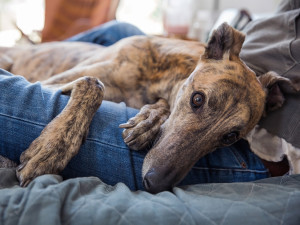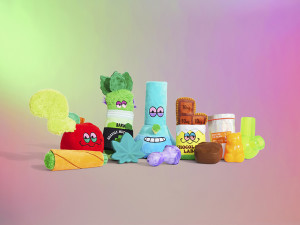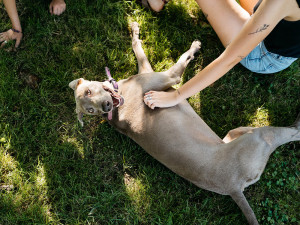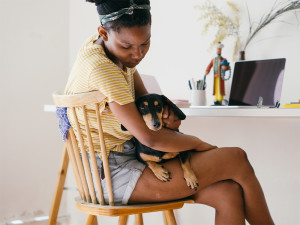How This CBD Brand Is Changing the Trauma Treatment Game For Pets
The founder of Heel on why full-spectrum CBD products can change your bestie’s entire life.

share article
Are all pet CBD products created equal? Not according to animal communicator Sarah Lea. Through her work with dogs coming from traumatic backgrounds, Lea knows the importance of using medicine as a tool in a larger healing repertoire, but noticed over time that both Western and plant medicine were failing the pups who needed the most help. That realization led Lea to start Heelopens in a new tab, a full-spectrum CBD pet brand that utilizes a formula based on Lea’s experience working with trauma in animals.
Recently, The Wildest chatted with Lea to learn more about what full-spectrum CBD can do for dogs, how being an animal communicator influenced her brand, and what pet parents should know about their dog’s inner world.
What inspired you to start Heel?
I have been working as an animal communicator for a long time and being in LA I started just being inundated with animals. You know, LA is like the home for rescue animals, rescue dogs. A lot of people are coming to me who have rescued dogs from the meat tradeopens in a new tab, testing labs, severe abuse situations, and puppy millsopens in a new tab, so I was seeing a lot of animals with trauma.
And I promise you like five, six, seven times a week someone would come to me with a dog that had been put on Xanax and Prozacopens in a new tab because they’re displaying anxiety. And, from my point of view, as an animal communicator who has the ability to understand animal psychology and the sentience of animals and see where the trauma sits in the body and the mind, the Xanax and Prozac was just numbing them, not addressing that experience they had been through.
So, what I started doing was using ashwagandha and full-spectrum hemp oil, coupled with the understanding that, “OK, this dog is displaying traumatic anxiety towards men.” But first, what the adaptogens and full-spectrum hemp oil were able to do is lift that curtain of anxiety to the side so that I could start rewiring their belief systems and start replacing the negative experience with a man with a positive one.
What makes Heel different from other CBD pet products?
Before I started the brand, I was obviously trying so many different things. Rhodiola, ashwagandha, Rescue Remedy, CBD full-spectrum, CBD isolate to find what was working. Through all the experience and the testimonials with different animals from different places I started to see the most effective thing is to combine ashwagandha and the full-spectrum CBD. I didn’t have positive results or see any change with animals that are using broad or isolated products. Because they’re not getting, like, the full symphony from the formula.
I believe in using a plant the way that nature intended and when you use the plant the way that nature intended, you’re using the full symphony. In addition to our formula, our big thing is using a pump instead of a dropper, because a dropper is super dangerous for animals. A glass dropper can obviously break in an animal’s mouth, while a plastic dropper can still gather bacterial biofilm from being in contact with an animal’s mouth, which can be super toxic to animals.
You mentioned being an animal communicator; when did you realize you had that gift?
I grew up in South Africa, and South Africans already naturally have a way different experience with animals because they’re around us all the time. And personally, I always had animals, all rescues — rescue horses, rescue dogs, you name it — so I was always around animals. So I always had a very good understanding of them, but I also just had this different understanding. I didn’t realize as a child that it was different to anybody else. However, I did experience trauma as a child, and being able to personally understand and see the nuances of trauma and how it affects the body and the mind and how it affects you moving forward, I’ve also been able to recognize that in animals.
Was there one animal in your life who particularly helped to inspire Heel?
I was fostering a dog called Almond who became my soul dog. He was severely abused; he was found chained in an abandoned house, riddled with fleas with burns on his skin. It was just terrible and, as a result, he was so deathly afraid of everything. And so I fostered him and it became a foster fail, obviously. And I started to be able to see his mind and understand where the trauma was sitting in the body and how it was affecting the way that he would understand the world and receive information, based off of his mental, emotional, and physical experience. So I started using full-spectrum CBD in a very strict routine, coupled with different exercises. And in the beginning this dog could not walk anywhere, he could not eat — he would sit under the table and shake just 24 hours a day.
And he went from that dog to a dog who would walk off leash alongside me. He was a completely different dog, and he was the biggest challenge for me because I thought I’d never be able to help him.
Speaking of the right tools, as an animal communicator is there one thing you wish pet parents knew about their pets’ inner worlds?
The first thing is that just the way that children are products of their environment, so are animals. For example, if a child comes from abuse, and then the child later gets adopted or fostered, you would be aware that the toddler has been through abuse and would have a certain belief system around that. It’s the exact same thing with animals.
Do not ignore the fact that your dog has a history, especially for rescue animals, and we should keep that in mind to make sure that they’re experiencing as much harmony moving forward. Now, not all of us can know the history of their rescue animals, and that’s where someone like me would come in. But even if you don't know their history, try noticing where their triggers are, what they feel peace about, what they don’t feel peace about.
What’s next for Heel?
We are coming out with some full-spectrum CBD treats that we’re really excited about, but for me the goal is for Heel to become the right tool for as many animals and people as possible.
Disclaimer alert: This article is here to share information. But, much like pineapple on pizza, the topic may be controversial. Meaning, not all vets or pet professionals agree. Because every pet is a unique weirdo with specific needs. So, don’t take this as fact or medical advice. Talk things over with your vet when making decisions, and use your best judgment (about both your pet’s health and pizza toppings).

Rebecca Caplan
Rebecca Caplan is a writer based in Brooklyn whose work has been featured in The New Yorker, Reductress, and Vulture. She lives in Brooklyn with her perfect, toothless dog Moose.
Related articles
![Close-up of a Merle coated Greyhound dog laying in the lap of their pet parent on the bed]() opens in a new tab
opens in a new tabHow to Give Relief to Your Dog With a Chronic Condition
What are the best ways to manage a dog’s pain?
![A display of dog toys and treats.]() opens in a new tab
opens in a new tabWe Highly Recommend BarkBox’s 4/20-Inspired Toys
The first box is only $4.20 for a limited time!
- opens in a new tab
Does Your Dog Need Anti-Anxiety Meds?
How to cope with dog anxiety—from training to medication.
![Girls Playing With Their Dog At The Park]() opens in a new tab
opens in a new tabResearch Confirms CBD Is a Safe Way to Get Your Dog to Chill Out
New research finds the hemp derivative can help your dog with car and separation anxiety.
![Young woman sitting in a chair holding and petting a small black Dachshund in her lap.]() opens in a new tab
opens in a new tabHow a Little of the Good Stuff (CBD) Can Help Your Dog With Seizures
Here’s the info you need before you buy.
![A white fluffy dog laying on a white surface next to a retro red colored TV and a bag of Dad Grass dog treats with some bone-shaped treats on the ground near the dog]() opens in a new tab
opens in a new tabDad Grass is Helping Dogs Light Up
With a new line of CBD-infused bones and pack-shaped plush toys, pups can munch to mellow out.






